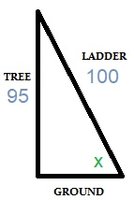In the second exercise (fill in the boxes), you filled in the first set of boxes with
\[\frac{sin(A)}{sin(B)} = cos(B)\]
Let's check that, by applying the right-triangle definitions for sine (Opposite/Hypotenuse) and cosine (Adjacent/Hypotenuse). For the side lengths, we use the standard symbols given in the diagram.
\[sin(A)=\frac{a}{c} \quad sin(B)=\frac{b}{c} \quad cos(B)=\frac{a}{c}\]
Substituting those ratios in your answer, we get:
\(\dfrac{\frac{a}{c}}{\frac{b}{c}} = \dfrac{a}{c}\)
\(\dfrac{a}{\cancel{c}} \cdot \dfrac{\cancel{c}}{b} = \dfrac{a}{c}\)
\(\dfrac{a}{b} = \dfrac{a}{c}\)
We get a false result, so the answer is not correct.
Here's a hint: The tangent of an angle may be written as the ratio of the angle's sine to its cosine. We state this fact as an identity -- an equation that's true for all angles x in the domain.
\[tan(x) = \frac{sin(x)}{cos(x)}\]
You can use this identity, to find a correct answer for the first set of boxes.
In the next set of boxes, you wrote \(sin(B) = tan(B)\)
We know this is not correct because sine (Opposite/Hypotenuse) is different than tangent (Opposite/Adjacent) for all angles other than the trivial case of 0º. Let's show how they differ for angle B, by applying the definition for each side:
\[sin(B)=\frac{b}{c} \quad tan(B)=\frac{b}{a}\]
Those ratios are not equal. Hint: Write the sine and cosine ratios for each angle A and B. Then you will see which ratios are equal.
In the last set of boxes, you wrote
\[tan(A) \cdot tan(B) = 1\]
We can check this, also, by using the right-triangle definition for tangent (Opposite/Adjacent).
\[tan(A)=\frac{a}{b} \quad tan(B)=\frac{b}{a}\]
Yes, your answer is correct because a/b and b/a are reciprocals, and we know the product of two reciprocals is always 1.
?

